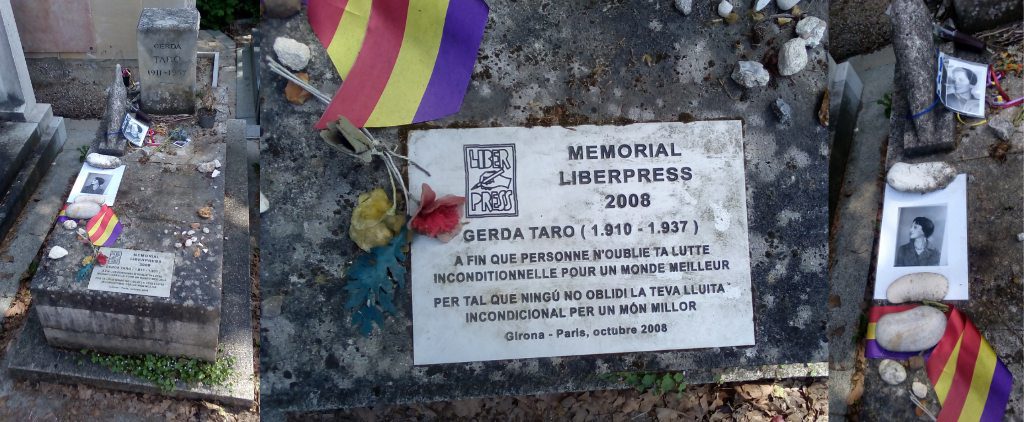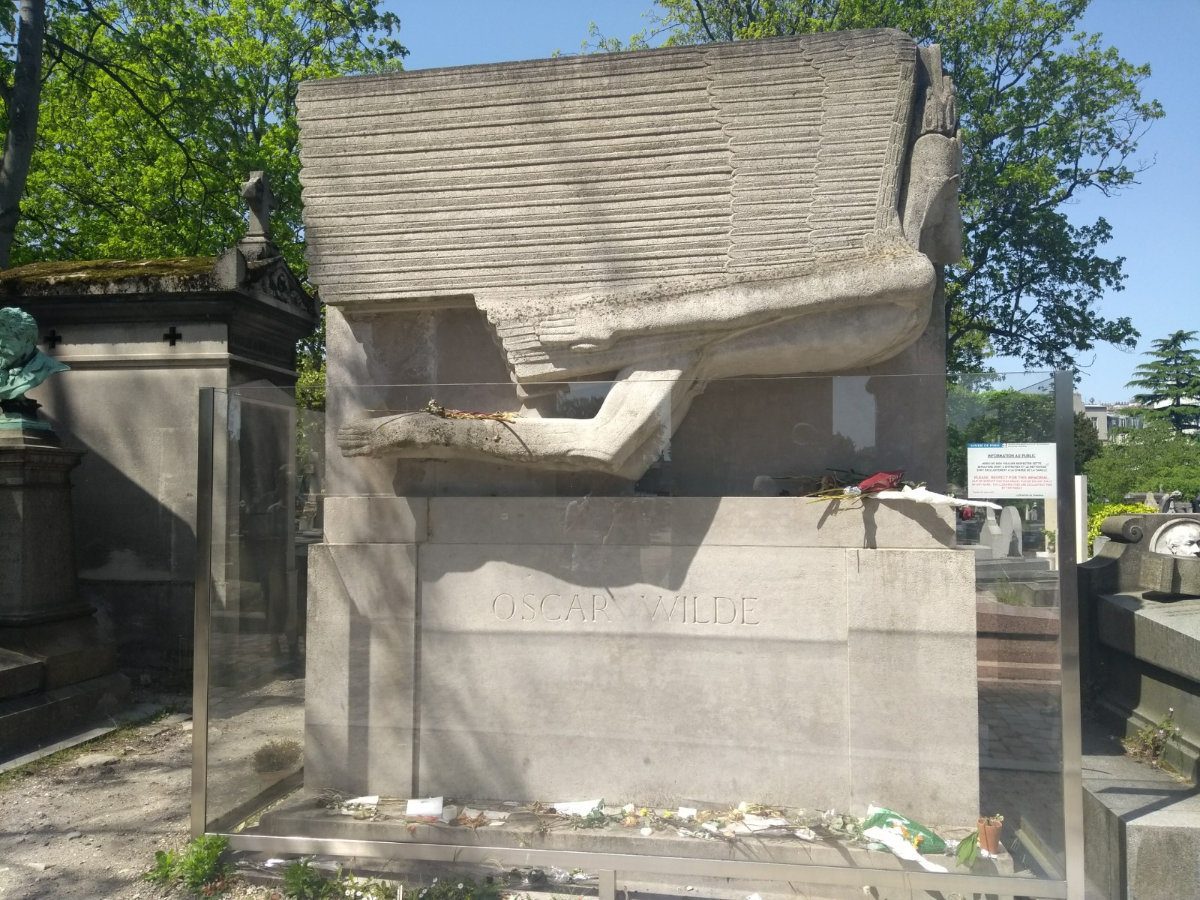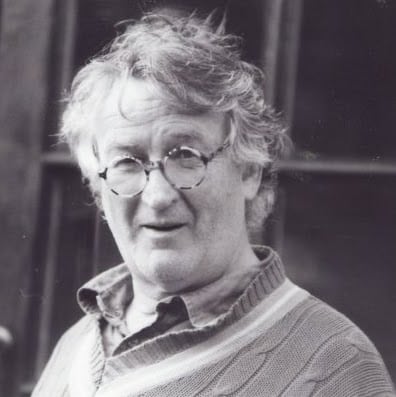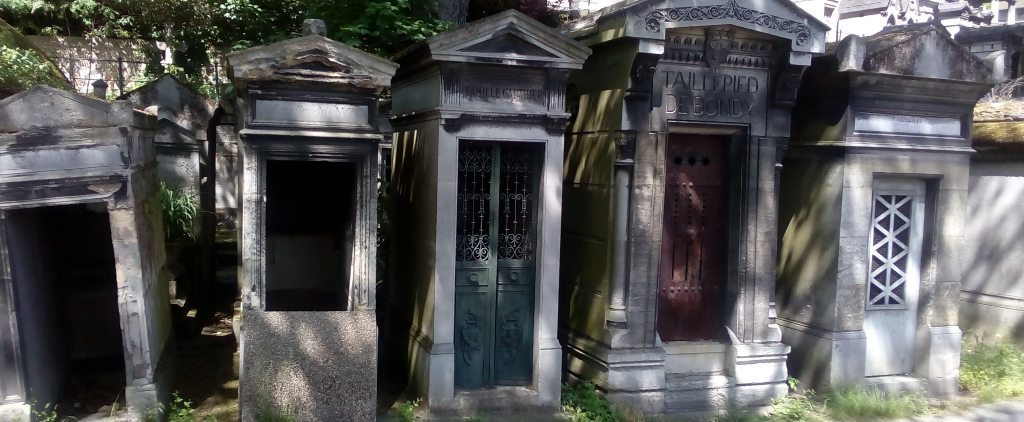Père Lachaise, May 2018, Pegs in the graveyard – the broken black teeth of a man long dead.
[dropcap style=”font-size:100px;color:#992211;]A[/dropcap]rchitecture, we might think, gains its aesthetic dimension from our sense of what it is to inhabit a space. It is the building that is beautiful; but what makes it beautiful is the thought of its accommodating our unfolding lives.
Strictly speaking no-one is buried in a cemetery. Since all that gets buried are mortal remains. The dead, as it were, are dearly departed.
What then must we think about funerary architecture of the cemetery?
One thing to notice is the predominance of classical details. Death, we might suppose, requires solemnity and a sense of the timeless. Classicism is an apt reminder that we are continuous with antiquity, from whence derives our civilization.
 Père Lachaise Cemetery, May 2018, (three details)
Père Lachaise Cemetery, May 2018, (three details)
Antiquity, in architectural myth, stretches back to when God gave the Ten Commandments to Moses. The English neo-classical architect Quinlan Terry believes that on that occasion God also gave Moses the plan and detailing of a temple in Classical style.
Exodus 31: 18 And he gave unto Moses, when he had made an end of communing with him upon mount Sinai, two tables of testimony, tables of stone, written with the finger of God.
But where is Terry’s proof that on the tablets of stone there were pictures of the classical orders?
‘We know from the Book of Exodus that the Tabernacle in the wilderness had a courtyard, and inside the Tabernacle had some columns, and between the holy place and the holy of holies were some other columns. I like to believe there would be some form of ornament on those columns, and the outer court would be simple – ie Doric, the entrance to the Tabernacle, which had so much to do with sacrifice, could have been the origin of the ram’s horns of the Ionic Order; and the most intricate part of the Tabernacle could have been a form of the Corinthian Order, because it was covered in gold and was very ornate. And that pattern was then picked up and reworked by Solomon in the Temple of Jerusalem, which of course predated Babylon, Persia, Greece. To say that the orders are Greek is very unscholarly because they went much further back.’ (Barber, 2004)
 The Tomb of Gerda Taro, Père Lachaise Cemetery, May 2018
The Tomb of Gerda Taro, Père Lachaise Cemetery, May 2018
All this aside, I was glad to find the tomb of Gerda Taro, the photo-journalist who volunteered to fight fascism in the Spanish Civil War. And glad to happen upon the tomb of Paul Elouard, the Dadaist, later Surrealist, poet.
They are both interred at the far corner of the cemetery – a pocket of the cemetery that has Gertrude Stein and Oscar Wilde within stumbling distance. I wonder if Taro, Stein and Elouard knew each other. Stein and Elouard must have done, since both were close friends of Picasso; and Paris was such a small place for bohemians just before the war.
Well, even if Oscar Wilde regards them as newcomers, they are all neighbours now. Only they are not; and for the reason set out above. They do not inhabit the cemetery.
Why, then, did I drift around the cemetery, looking for Gerda Taro’s tomb and eager to stand at the foot of graves of those whose lives I have admired? It puzzles me.
Is mourning utterly irrational?
When we mourn, we are connecting ourselves with a community of souls, each of whom commands respect. Traditions, customs and enshrined values include both the dead and alive; and indeed, those who are yet to be.
We have duties to ourselves but also to the dead, and to the unborn.
That is why it so important to have pardoned Oscar Wilde under the ‘Turin Law’ (2017) for his so called ‘gross indecency’.
 Tomb of Oscar Wilde, Père Lachaise Cemetery, Paris. (Photograph: Mark Perry)
Tomb of Oscar Wilde, Père Lachaise Cemetery, Paris. (Photograph: Mark Perry)
When we regard infants, we do so with respect for them as persons, even when they are too young to have grasped reason. We look upon them, not as persons, capable of making decisions or of being fully responsible for their actions, but as persons in potentia. That is, we come to regard them as future persons who will have reason and will be culpable for their actions. As such we recognize duties toward them.
Is this a way of re-interpreting our responses to the dead? They are no longer persons, but they demand our respect precisely because they once were.
We do not live with the dead but we abide by them, as they abide with us. When I stand beside the tomb of Gerda Taro, I am brought to silence, not by her presence, but by her abiding memory.
The tomb makes sacred a life now ended and accounted for. I may put flowers on her grave as a symbol of my respect. She is no longer a person but the life she led deserves enduring respect. Even although I know her only through testimony.
Taro (real name, Gerta Pohorylle) moved to Paris in 1934, where she met Hungarian photo-journalist, Endre Ernő Friedmann.
Both were Jewish and each was fleeing oppression from their respective homelands. Taro had already been arrested in Germany for distributing anti-fascist literature.
The two invented an American photo-journalist, Robert Capa, whose work they were able to sell for three times the going rate, Americans being granted such kudos. They were soon discovered but by then their work had become so successful it didn’t matter.
Friedman became Capa, and the pair went to cover the Republican side of the Spanish Civil War.
Taro met her death in a tragic accident whilst returning from the front at the battle of Brunete. It was a sad end, a stupid end, as stupid as war itself. It was a pitiful end to such a courageous, reckless, wonderful life. She was beautiful, too. Perhaps that shouldn’t affect my response; but it does. It ended thus,
Taro had ignored warnings from Capa and others to stay away from the frontline at one of the most dangerous moments in the war and, having used up all her film, had hitched a ride on the running boards of a general’s car that was being used to ferry the injured. As they were strafed by German aircraft supporting Franco’s troops near Villanueva de la Cañada, an out-of-control tank from the republican army ran into them and she was mortally wounded in the stomach. (Tremlett, 2018)
Why visit her tomb? My visit to her grave is not a visit to her home, but it is a visit to her abode. In cemeteries, the dead abide. In standing silently beside the graves, we mourn their passing, even as we abide with them.
A brief account of Gerda Taro’s love affair and photographic practice with Robert Capa is told in ‘Robert Capa and Gerda Taro: love in a time of war,’ (O’Hagan, 2012)
References:
Lynn Barber interview with Quinlan Terry, ‘The Shock of the Old,’ Observer, 7th March 2004.
Sean O’Hagan, Guardian, ‘Robert Capa and Gerda Taro: love in a time of war,’ Sunday 13th May, 2012.
Giles Tremlett, ‘”Deathbed photo” of war photographer Gerda Taro discovered’ Guardian, Fri 19 Jan 2018 15.07 GMT.
Edward Winters is living in Paris, writing a book on the aesthetics of everyday life
Photographs are, unless stated, by the author.

Ed studied painting at the Slade School of Fine Art and later wrote his PhD in Philosophy at UCL. He has written extensively on the visual arts and is presently writing a book on everyday aesthetics. He is an elected member of the International Association of Art Critics (AICA). He taught at University of Westminster and at University of Kent and he continues to make art.

















I remember being taken there by my mom, who then decided to enter as many underground cavities as she could find. I’m not sure that was legal… although this was in the 1960. Man she scared me witless! Also I have way too many friends who’d funerals were held there….
A la dérive…